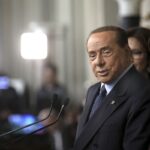Russian President Vladimir Putin announced the latest escalation of his war in Ukraine on Wednesday, declaring martial law in occupied areas of Ukraine and wartime measures throughout much of Russia.
Ukrainian officials said the order would not deter their efforts to retake occupied territory, but warned it could mean mass deportations of Ukrainians out of the occupied regions, and harsher treatment for those that remain.
Experts said the order could also be a “back door” to pull more of Russian society into the war effort, strengthening Putin’s footing for future offensives but weakening his claim that the “special military operation” in Ukraine is not a full-fledged war.
“This is a big deal because in effect what Putin is doing is actually bringing all the Russian Federation into some level of martial law,” said Mark Galeotti, an honorary professor at the University College London’s School of Slavonic and East European Studies.
“In terms of sort of shifting to a sort of model of national mobilization of every aspect of politics, society and economics, you know, this is definitely a move that up to now Putin has been trying to avoid.”
While the martial law order mainly applies to the four occupied regions of Ukraine — Donetsk, Luhansk, Zaporizhzhia and Kherson — it also announced the “economic mobilization” of eight Russian regions on Ukraine’s border, including occupied Crimea.
And the final section says that “other measures may be applied in the Russian Federation during the period of martial law.”
What it means for Ukraine


Ukrainian soldiers sit on an armoured vehicle as they drive on a road between Izium and Lyman, recently retaken areas in Ukraine, on Oct. 4, 2022. (AP Photo/Francisco Seco, File)
Ukrainian President Volodymyr Zelensky’s office was quick to minimize the significance of Putin’s order.
“‘Martial law’ implementation on the occupied territories by [Russia] should be considered only as a pseudo-legalization of looting of Ukrainians’ property by another ‘regrouping,’” Mykhailo Podolyak, a Zelensky adviser, wrote on Twitter.
“This does not change anything for Ukraine: we continue the liberation and de-occupation of our territories,” he continued.
However, local Ukrainian officials warned that Putin’s move could begin an even darker chapter in territories that Moscow illegally annexed earlier this month.
“A new manifestation of genocide in the occupied territories,” Melitopol Mayor Ivan Fedorov wrote on Telegram. “The Ruscists are preparing the forcible deportation of an entire city. So far, it is between voluntary and forcible, supposedly aimed to protect people from hostilities.”
Oleksiy Danilov, secretary of Ukraine’s National Security and Defense Council, wrote on Twitter that “Putin’s martial law in the annexed regions of [Ukraine] is preparation for the mass deportation of the Ukrainian population to depressed areas of [Russia] in order to change the ethnic composition of the occupied territory.”
Eugene Finkel, an associate professor at the Johns Hopkins School of Advanced International Studies, who was born in Ukraine, said he didn’t expect the order would significantly change the situation on the ground.
“I don’t think that having a martial law in place was the only thing that prevented Russians from carrying out those things, it certainly will give them some veneer of domestic legitimacy — obviously zero external legitimacy,” he said.
Russia has already been accused of overseeing filtration camps in occupied areas, in which thousands of Ukrainians are sent to Russia, while its troops have reportedly committed an array of war crimes, from rape to torture to mass executions.
In announcing the new order on Wednesday, Putin told Russia’s Security Council that officials in the annexed regions should enact measures necessary to ensure the safety of the people, protect critical infrastructure, maintain public order and “increase the manufacturing of products necessary for the special military operation.”
He also noted that Ukraine had already declared its own martial law in the occupied regions following Russia’s invasion, and he said extraordinary measures were necessary to counter Ukrainian aggression.
“The neo-Nazis are using plainly terrorist methods, plotting sabotage at critical infrastructure, attempting to murder members of local authorities,” he said, referring to Ukraine’s government, according to the Kremlin.
What it means for Russia


Russian recruits take a bus near a military recruitment center in Krasnodar, Russia, Sunday, Sept. 25, 2022. (AP Photo, File)
Putin’s order is his latest move to signal action in Ukraine as Russia’s military has faced a string of embarrassing losses in the northeast, and may soon lose its hold on Kherson in the south.
His mobilization drive in recent weeks has stirred up significant domestic discontent, as war hawks have spoken out against the failures of Putin’s generals and urged for more aggressive action to regain momentum.
While his martial law declaration was focused largely on Ukraine and border regions in Russia, Finkel said the final provision allowing for “other measures” could be a “backdoor to introduce martial law in other parts of Russia without actually calling it martial law.”
“And also a signal to the population that they’re doing something and something’s happening, because everybody knows that the war isn’t going as they planned,” he added.
Galeotti said this could have broad implications for Russian society, allowing officials to control industrial activity to help the war, further control the media or crush labor actions that conflict with wartime priorities.
“I think in terms of what this shows is a growing awareness that Russia is in this probably for the long haul,” said Galeotti, who wrote the book “Putin’s Wars: From Chechnya to Ukraine.”
Putin conveyed a similar message during his meeting the Security Council on Wednesday, in which he also ordered the creation of a special coordinating council to carry out the measures.
“We are working on solving very complex, large-scale tasks to ensure a reliable future for Russia, the future of our people,” he said.
For the latest news, weather, sports, and streaming video, head to The Hill.




